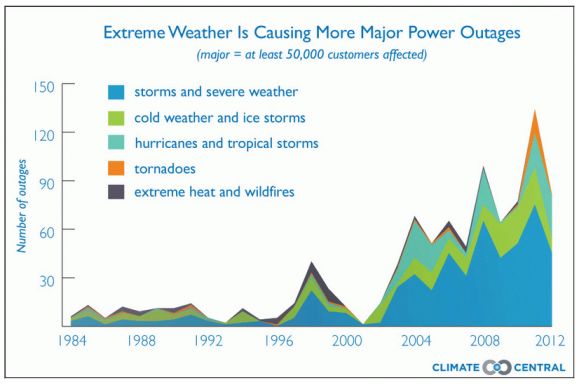In yet another development in President Obama's climate plan, the government is putting more than $1.2 billion behind programs to prepare the electric grid and rural communities for extreme weather events.
The funding announcement is more proof of how important the concept of resiliency has become on the federal and state levels over the last two years.
When the president started traveling the country in 2009 to tout the government's stimulus investments in smart grid technologies, resiliency never came up. Rather, the messaging was framed almost entirely around economic opportunities and job creation.
But as chronicled in our recent e-book, the government's strategy has dramatically shifted course since Superstorm Sandy. With climate change at the top of the president's agenda, resiliency planning -- making the energy sector and communities more adaptive and responsive to extreme events -- has become a central focus.
Resiliency has become much more than a buzzword. It's driving big state and federal investments in microgrids, smart grid technologies and hardening efforts. And the White House is once again reaffirming that change in focus with its latest announcement for infrastructure improvements.
The package includes $236 million through the Department of Agriculture to support grid modernization in rural areas, with a focus on information technologies like smart meters and fault detection in order to respond to outages faster.
In addition, the administration is releasing new details about a $1 billion competition to help communities develop smarter and more robust infrastructure. (This is one piece of Obama's new push to update America's roads and bridges, which are in very poor shape.) The first part of the competition will focus on using open-source information to respond and prepare for extreme events. The second part will provide more funding to a select number of communities to advance programs to later stages.
Another $10 million will go to tribal communities to help them develop similar initiatives.
Superstorm Sandy was a catalyst for new government resiliency programs. But the influence of extreme weather within the energy sector goes well beyond a single storm. As a recent report from Climate Central showed, there has been a steady rise in power outages from extreme weather events over the decades.

Since 1951, heavy downpours have increased in the Northeast U.S. by 74 percent, in the Midwest by 45 percent and in the Southeast by 26 percent. Since the 1980s, there has been an increase in the number and strength of Category 4 and 5 hurricanes forming in the Atlantic Ocean, even though few have made landfall.
In addition, the documented increase in extreme heat, wildfires and drought will continue to challenge the power sector over the coming decades.
The latest round of funding from the Obama administration comes as states around the country are investing hundreds of millions of dollars into microgrids, battery storage, information technologies and infrastructure hardening efforts. Meanwhile, some utilities on the East Coast are grappling with how these technologies may change their business models in the coming years.
Indeed, as we've pointed out, resiliency planning will continue to have a lasting impact on America's electricity system.
For more on the implications of this shift, read Greentech Media's e-book, called Resiliency: How Superstorm Sandy Changed America's Grid.
Also, listen to the Energy Gang podcast embedded below, in which we lay out how utilities are changing their planning outlook in a new era of extreme weather.



